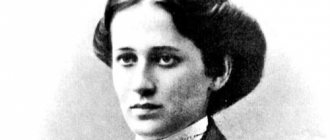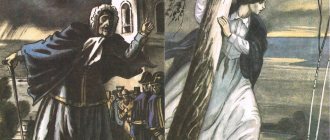"REQUIEM"
History of creation. The poem “Requiem” is one of the pinnacle works of A.A.’s late work. Akhmatova. The poem was written in the period from 1935 to 1940. Until mid-1962, the work did not have a handwritten text, but lived in the memory of Akhmatova and several of her closest friends. The story of the creation of this hidden document of the era is as follows: Akhmatova lived in the belief that a listening device was installed in her room, so the verses from the “Requiem” were usually not spoken out loud, but written down on a piece of paper, memorized, and then burned. The last reading of the full text of the work before the Requiem was retyped took place on May 27, 1962. On this day, in a public garden on Ordynka, L.K. Chukovskaya, at Akhmatova’s request, read the entire “Requiem”. L.K. Chukovskaya recalls this event this way: “She listened, and I read aloud the poems that I had repeated to myself so many times. She untied the knot of her scarf and opened her coat. She listened to my voice, peered at the trees and cars. She was silent. I read every single one. I asked if she was going to write them down now. “I don’t know,” she answered, from which I understood that I also did not have the right to write it down yet.” The idea of the poem is explained by Akhmatova herself in the preface to “Requiem”: “During the terrible years of the Yezhovshchina, I spent seventeen months in prison lines in Leningrad. One day someone “identified” me. Then a woman standing behind me with blue lips, who, of course, had never heard my name in her life, woke up from the stupor that is characteristic of us all and asked me in my ear (everyone there spoke in a whisper): “Can you describe this?” And I said: “I can.” Then something like a smile crossed what had once been her face.”
The history of the creation of the Poem "Requiem"
3.5 (70%) 2 votes
Searched on this page:
- the history of the creation of the poem requiem
- The history of the creation of the poem Requiem by Akhmatova
- The history of the creation of Akhmatov's requiem
- history of the creation of requiem
- Akhmatova Requiem history of creation
Anna Akhmatova is my favorite poetess, whom I read with pleasure. Her works both inspire and make us think about life, about the past fate of the Russian people. This is a poetess of the twentieth century, whose spirit was broken by the sorrows that were sent to her by fate. She created by describing the challenges she faced. She also created such a work as Requiem, on which we will write, dwelling on the history of the creation of this poem.
Anna Akhmatova: poem Requiem
Akhmatova's poem Requiem is a work that touches on the terrible years that changed the entire country. Years of repression and persecution, years of arrests of innocent people, arbitrariness of the authorities. These are endless queues at prisons, in which relatives stood to see the relatives of the prisoners, the relatives of the prisoners. The arrests also affected Akhmatova’s life, because she also had to stand in the same lines when her son was arrested. In the work, Anna poured out her soul and showed all the sorrows that touched her life, and not only family pain is shown in the poem, the general people’s pain poured out here.
Let us dwell on the history of the creation of Anna Akhmatova’s poem Requiem. What is this story?
The history of creation occurred during difficult years for the country and the poem Requiem took six years to create. The idea appeared at a time when the poetess was standing in a prison line to visit her son, who was accused of participating in an anti-Soviet terrorist group. There, a certain woman, recognizing Anna Akhmatova, asked to describe everything that was happening. Anna agreed. Anna wrote about her idea in the preface.
In general, Akhmatova’s son was taken into custody several times. This first happened in 1935 and his mother managed to achieve his quick release by turning to Stalin. Then the second arrest in 1938. In 1939 - the third arrest and sentence - execution. But the sentence is replaced by exile.
Returning to the history of the creation of Akhmatova’s Requiem, the poetess made her first sketches in 1934-1935. She wanted to publish poems in the planned lyric cycle, but her son’s second arrest unsettles her. Now she has set a goal to show the whole truth, to convey to society and show readers all the horror and all the pain that people experienced during the years of repression. So the lyrical cycle became a poem, which the poetess began writing in 1938-1940. She finished writing in the fifties. The work is not printed immediately, but is passed on to each other in single copies. She became very popular.
It was first published in Munich in 1963, but this was only part of the poem. The entire Requiem was published only in 1987. And so the Requiem was released, consisting of different parts. The poem, which at one time was not read out, but written down on small pieces of paper, was memorized, and then burned. We can now, without fear of anything, read the work out loud and set ourselves as an example the wonderful poetess Anna Akhmatova.
Anna Andreevna Akhmatova is one of the greatest poets of the 20th century. A woman whose tenacity and devotion were admired in Russia. The Soviet government first took her husband, then her son, her poetry was banned, and the press persecuted her. But no sorrows could break her spirit. And Akhmatova embodied the trials that befell her in her works. “Requiem,” the history of creation and analysis of which will be discussed in this article, became the poetess’s swan song.
The idea of the poem
In the preface to the poem, Akhmatova wrote that the idea for such a work arose during the years of the Yezhovshchina, which she spent in prison queues, seeking a meeting with her son. One day they recognized her, and one of the women asked if Akhmatova could describe what was happening around her. The poetess replied: “I can.” From that moment on, the idea of the poem was born, as Akhmatova herself claims.
“Requiem,” the creation of which is connected with very difficult years for the Russian people, was suffered through the writer’s suffering. In 1935, the son of Akhmatova and Nikolai Gumilev, Lev Gumilev, was arrested for anti-Soviet activities. Then Anna Andreevna managed to quickly free her son by writing a letter to Stalin personally. But in 1938 a second arrest followed, then Gumilyov Jr. was sentenced to 10 years. And in 1949, the last arrest was made, after which he was sentenced to death, which was later replaced by exile. A few years later he was completely rehabilitated, and the charges were declared unfounded.
Akhmatova’s poem “Requiem” embodied all the sorrows that the poetess endured during these terrible years. But not only family tragedy is reflected in the work. It expressed the grief of all the people who suffered at that terrible time.
Dedication
Before this grief the mountains bend, the great river does not flow, but the prison gates are strong, and behind them are “convict holes” and mortal melancholy. For some, the fresh wind is blowing, For others, the sunset is basking - We don’t know, we are the same everywhere, We only hear the hateful grinding of keys and the heavy footsteps of soldiers. They rose as if to an early mass, They walked through the wild capital, There they met, more lifeless dead, The sun is lower, and the Neva is foggy, And hope still sings in the distance. The verdict... And immediately tears flow, Already separated from everyone, As if life had been taken out of the heart with pain, As if rudely knocked over, But she walks... She staggers... Alone. Where are the unwitting friends of my two maddened years now? What do they see in the Siberian blizzard, What do they see in the circle of the moon? To them I send my farewell greetings.
March 1940
First lines
The sketches appeared in 1934. But this was a lyrical cycle, the creation of which was originally planned by Akhmatova. “Requiem” (the history of whose creation is our topic) became a poem later, already in 1938-40. The work was completed already in the 50s.
In the 60s of the 20th century, the poem, published in samizdat, enjoyed enormous popularity and was passed from hand to hand. This is due to the fact that the work was banned. Akhmatova suffered a lot to preserve her poem.
Analysis
The theme of Akhmatova’s poem “Requiem” is the suffering of a person for his loved ones, whose life hangs in the balance. The work consists of poems written in different years. But they are all united by a mournful and mournful sound, which is already included in the title of the poem. A requiem is something intended for a funeral service.
In her prosaic preface, Akhmatova states that the work was written at someone else’s request. Here the tradition laid down by Pushkin and Nekrasov manifested itself. That is, fulfilling the order of a common man, who embodies the will of the people, speaks of the civic orientation of the entire work. Therefore, the heroes of the poem are all those people who stood with her under the “blind red wall.” The poetess writes not only about her own grief, but also about the suffering of the entire people. Therefore, her lyrical “I” is transformed into a large-scale and all-encompassing “we”.
The first part of the poem, written in three-foot anapest, speaks of its folklore orientation. And the images (dawn, a dark room, an arrest similar to the removal of a body) create an atmosphere of historical authenticity and lead to the depths of centuries: “I am like the Streltsy’s wives.” Thus, the suffering of the lyrical heroine is interpreted as timeless, familiar to women even in the years of Peter the Great.
The second part of the work, written in trochaic tetrameter, is designed in the style of a lullaby. The heroine no longer laments or cries, she is calm and restrained. However, this humility is feigned; real madness grows inside her from the grief she is experiencing. At the end of the second part, everything in the thoughts of the lyrical heroine is confused, madness takes possession of her completely.
The culmination of the work was the chapter “Towards Death”. Here the main character is ready to die in any way: at the hands of a bandit, illness, or a “shell.” But there is no deliverance for the mother, and she literally turns to stone from grief.
VIII. To death
You will come anyway - why not now? I'm waiting for you - it's very difficult for me. I turned off the light and opened the door to You, so simple and wonderful. To do this, take on any form you like, Burst in with a poisoned shell, Or sneak up with a weight like an experienced bandit, Or poison with a typhoid child, Or with a fairy tale invented by you And sickeningly familiar to everyone - So that I can see the top of a blue hat And the building manager pale with fear. I don't care now. The Yenisei swirls, the Polar Star shines. And the blue shine of beloved eyes obscures the last horror.
Fountain House August 19, 1939
Brief Analysis
Year of writing
– 1938-1940.
History of creation
– The history of writing the poem is closely connected with the personal tragedy of the poetess, whose husband was shot during the reaction period and whose son was arrested. The work is dedicated to all those who died during the period of repression only because they dared to think differently than what was required by the current government.
Subject
– In her work, the poetess revealed many topics, and they are all of equal importance. This is the theme of folk memory, grief, maternal suffering, love and homeland.
Composition
– The first two chapters of the poem form a prologue, and the last two form an epilogue. The 4 verses following the prologue are a summary of maternal grief, chapters 5 and 6 are the culmination of the poem, the highest point of the heroine’s suffering. Subsequent chapters focus on the topic of memory.
Genre
- Poem.
Direction
- Acmeism.
History of creation
The first sketches of "Requiem" date back to 1934. Initially, Anna Andreevna planned to write a cycle of poems dedicated to the reactionary period. One of the first victims of totalitarian tyranny were the closest and dearest people of the poetess - her husband, Nikolai Gumilev, and their common son, Lev Gumilev. The husband was shot as a counter-revolutionary, and the son was arrested only because he bore his father’s “shameful” surname.
Realizing that the reigning regime was merciless in its bloodthirstiness, Akhmatova after a while changed her original plan and began writing a full-fledged poem. The most fruitful period of work was 1938-1940. The poem was completed, but for obvious reasons was not published. Moreover, Akhmatova immediately burned the manuscripts of “Requiem” after reading them to her closest people, whom she trusted infinitely.
In the 60s, during the Thaw period, Requiem began to gradually spread among the reading public thanks to samizdat. In 1963, one of the copies of the poem went abroad, where it was first published in Munich.
The full version of “Requiem” was officially approved for publication only in 1987, with the beginning of Perestroika in the country. Subsequently, Akhmatova’s work was included in the compulsory school curriculum.
The meaning of the poem's title
is quite deep: requiem is a religious term meaning the holding of a funeral church service for a deceased person. Akhmatova dedicated her work to all prisoners - victims of the regime, who were destined for death by the ruling power. This is the heartbreaking cry of all mothers, wives and daughters who see off their loved ones on the chopping block.
Musical arrangements[ | ]
The requiem was set to music by Vladimir Dashkevich, for a symphony orchestra, male choir and soloist. Soloist: Elena Kamburova. Recording and first performance took place in 1989.
Elena Firsova's Requiem for soprano, choir and orchestra was written based on texts from the poem. The first performance took place in 2003 in Berlin and achieved great critical success[2].
Composer Georgiy Dmitriev wrote a cantata called “Stabat Mater Dolorosa (Standing the Grieving Mother...)”, which uses the poem “Requiem”. The composer dedicated the cantata to his mother. At the moment, “Stabat Mater Dolorosa” is in the repertoire of the Bolshoi Children’s Choir. V. S. Popov Russian State Broadcasting.
In 1966, composer Boris Tishchenko created a Requiem for soprano, tenor and symphony orchestra based on poems by Anna Akhmatova (op. 35).
"Akhmatova Requiem"[ | ]
In 1980, the Orthodox English composer Sir John Tavener wrote music entitled "Akhmatova Requiem". This work for soprano (text of the poem) and bass-baritone (additions by Tavener) completely follows Akhmatova’s work except for “Instead of a Preface” (autoepigraph - see above), work to which Taverner added the voice of the 8th kontakion of the memorial service (“Rest with the saints ..." at the end of the "Dedication" and before the "Sentence") and included in the "Crucifixion" the irmos of the tenth song of the canon of Cosmas Mayumsky for Holy Saturday:
Akhmatova (bass): Don’t cry for Me, Mother, / see me in the grave.
Tavener (bass): ...seeing in the tomb. And you conceived Him in your womb without seed, a Son:
Akhmatova (soprano and bass): The choir of angels glorified the great hour, / And the heavens melted in fire. / He said to his father: “Why has he forsaken Me!” / And to his mother: “Oh, do not weep for Me...”
Tavener (bass): I will arise and be glorified, and I will exalt you with glory unceasingly, like God, magnifying You with faith and love.
Subject
Theme of national suffering
is revealed by the poetess through the prism of her own, personal tragedy. At the same time, she draws parallels with mothers from different historical eras, who sent their innocent sons to death in the same way. Hundreds of thousands of women literally lost their minds in anticipation of a terrible sentence that would forever separate them from a loved one, and this pain is timeless.
In the poem, Akhmatova experiences not only personal grief, she is heartbroken for her patronymic, which is forced to become an arena for the senselessly cruel executions of her children. She identifies her homeland with a woman forced to look helplessly at the torment of her child.
The poem perfectly reveals the theme of boundless love.
, stronger than which there is nothing in the world. Women are not able to help their loved ones who find themselves in trouble, but their love and loyalty can warm them during the most difficult trials in life.
The main idea of the work
- memory. The author calls to never forget about the people's grief, and to remember those innocent people who became victims of the merciless machine of power. This is part of history, and erasing it from the memory of future generations is a crime. Remembering and never allowing a repetition of a terrible tragedy is what Akhmatova teaches in her poem.
Composition
Carrying out an analysis of the work in the poem “Requiem”, it should be noted the peculiarity of its compositional structure, indicating Akhmatova’s original intention - to create a cycle of completed individual poems. As a result, it seems that the poem was written spontaneously, in fits and starts, in separate parts.
- The first two chapters (“Dedication” and “Introduction”) are the prologue of the poem. Thanks to them, the reader learns what the place and time of the work is.
- The next 4 verses present historical parallels between the bitter fate of mothers of all times. The lyrical heroine recalls her youth, which did not know any problems, the arrest of her son, and the days of unbearable loneliness that followed.
- In chapters 5 and 6, the mother is tormented by the premonition of her son’s death, she is frightened by the unknown. This is the culmination of the poem, the apotheosis of the heroine’s suffering.
- Chapter 7 - a terrible sentence, a message about the exile of his son to Siberia.
- Verse 8 - the mother, in a fit of despair, calls for death, she wants to sacrifice herself, but protect her child from the evil fate.
- Chapter 9 is a prison meeting, forever etched in the memory of the unfortunate woman.
- Chapter 10 - in just a few lines, the poetess draws a deep parallel between the suffering of her son and the torment of the innocent crucified Christ, and compares her maternal pain with the anguish of the Mother of God.
- In the epilogue, Akhmatova calls on people not to forget the suffering that the people endured during those terrible years of repression.
IX
Madness has already covered half of the Soul with its wing, and feeds it with fiery wine, and beckons into the black valley.
And I realized that I must give up victory to him, Listening to my own, as if someone else’s, delirium.
And It won’t allow me to take anything with me (No matter how much you beg it and no matter how much you pester it with prayer):
Not the son's terrible eyes - Petrified suffering, Not the day when the thunderstorm came, Not the hour of the prison meeting,
Neither the sweet coolness of hands, nor the linden worried shadows, nor the distant light sound - Words of final consolation.
Fountain House May 4, 1940








